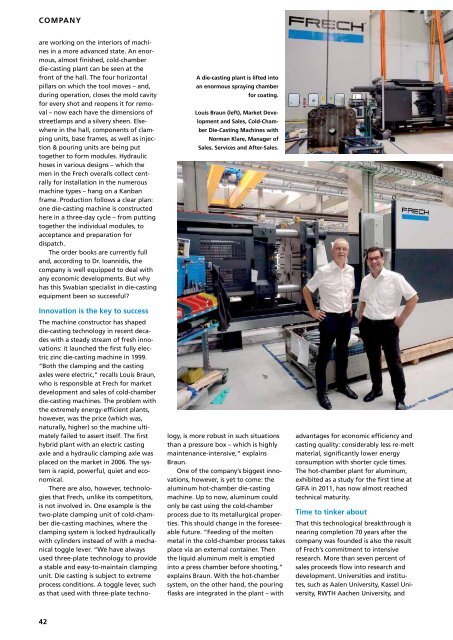CPT International 4/2019
Create successful ePaper yourself
Turn your PDF publications into a flip-book with our unique Google optimized e-Paper software.
COMPANY<br />
are working on the interiors of machines<br />
in a more advanced state. An enormous,<br />
almost finished, cold-chamber<br />
die-casting plant can be seen at the<br />
front of the hall. The four horizontal<br />
pillars on which the tool moves – and,<br />
during operation, closes the mold cavity<br />
for every shot and reopens it for removal<br />
– now each have the dimensions of<br />
streetlamps and a silvery sheen. Elsewhere<br />
in the hall, components of clamping<br />
units, base frames, as well as injection<br />
& pouring units are being put<br />
together to form modules. Hydraulic<br />
hoses in various designs – which the<br />
men in the Frech overalls collect centrally<br />
for installation in the numerous<br />
machine types – hang on a Kanban<br />
frame. Production follows a clear plan:<br />
one die-casting machine is constructed<br />
here in a three-day cycle – from putting<br />
together the individual modules, to<br />
acceptance and preparation for<br />
dispatch.<br />
The order books are currently full<br />
and, according to Dr. Ioannidis, the<br />
company is well equipped to deal with<br />
any economic developments. But why<br />
has this Swabian specialist in die-casting<br />
equipment been so successful?<br />
A die-casting plant is lifted into<br />
an enormous spraying chamber<br />
for coating.<br />
Louis Braun (left), Market Development<br />
and Sales, Cold-Chamber<br />
Die-Casting Machines with<br />
Norman Klare, Manager of<br />
Sales, Services and After-Sales.<br />
Innovation is the key to success<br />
The machine constructor has shaped<br />
die-casting technology in recent decades<br />
with a steady stream of fresh innovations:<br />
it launched the first fully electric<br />
zinc die-casting machine in 1999.<br />
“Both the clamping and the casting<br />
axles were electric,” recalls Louis Braun,<br />
who is responsible at Frech for market<br />
development and sales of cold-chamber<br />
die-casting machines. The problem with<br />
the extremely energy-efficient plants,<br />
however, was the price (which was,<br />
naturally, higher) so the machine ultimately<br />
failed to assert itself. The first<br />
hybrid plant with an electric casting<br />
axle and a hydraulic clamping axle was<br />
placed on the market in 2006. The system<br />
is rapid, powerful, quiet and economical.<br />
There are also, however, technologies<br />
that Frech, unlike its competitors,<br />
is not involved in. One example is the<br />
two-plate clamping unit of cold-chamber<br />
die-casting machines, where the<br />
clamping system is locked hydraulically<br />
with cylinders instead of with a mechanical<br />
toggle lever. “We have always<br />
used three-plate technology to provide<br />
a stable and easy-to-maintain clamping<br />
unit. Die casting is subject to extreme<br />
process conditions. A toggle lever, such<br />
as that used with three-plate technology,<br />
is more robust in such situations<br />
than a pressure box – which is highly<br />
maintenance-intensive,” explains<br />
Braun.<br />
One of the company’s biggest innovations,<br />
however, is yet to come: the<br />
aluminum hot-chamber die-casting<br />
machine. Up to now, aluminum could<br />
only be cast using the cold-chamber<br />
process due to its metallurgical properties.<br />
This should change in the foreseeable<br />
future. “Feeding of the molten<br />
metal in the cold-chamber process takes<br />
place via an external container. Then<br />
the liquid aluminum melt is emptied<br />
into a press chamber before shooting,”<br />
explains Braun. With the hot-chamber<br />
system, on the other hand, the pouring<br />
flasks are integrated in the plant – with<br />
advantages for economic efficiency and<br />
casting quality: considerably less re-melt<br />
material, significantly lower energy<br />
consumption with shorter cycle times.<br />
The hot-chamber plant for aluminum,<br />
exhibited as a study for the first time at<br />
GIFA in 2011, has now almost reached<br />
technical maturity.<br />
Time to tinker about<br />
That this technological breakthrough is<br />
nearing completion 70 years after the<br />
company was founded is also the result<br />
of Frech’s commitment to intensive<br />
research. More than seven percent of<br />
sales proceeds flow into research and<br />
development. Universities and institutes,<br />
such as Aalen University, Kassel University,<br />
RWTH Aachen University, and<br />
42

















